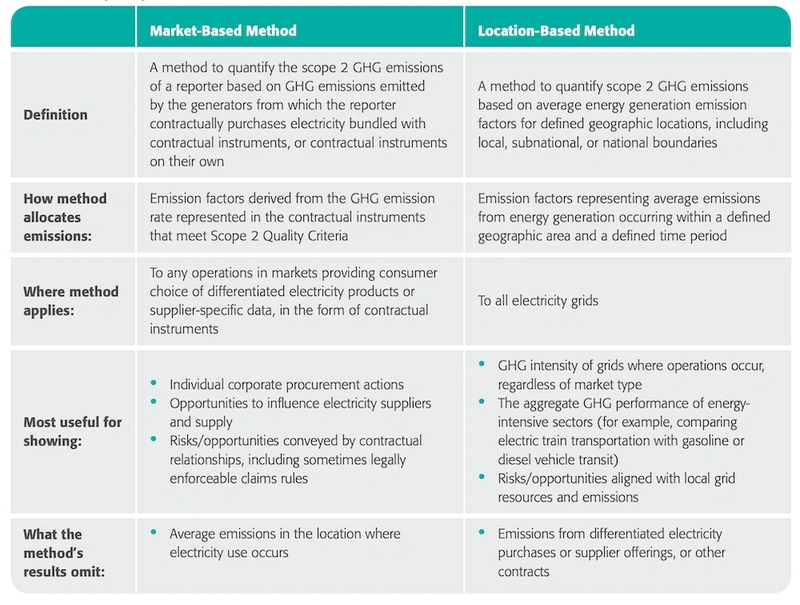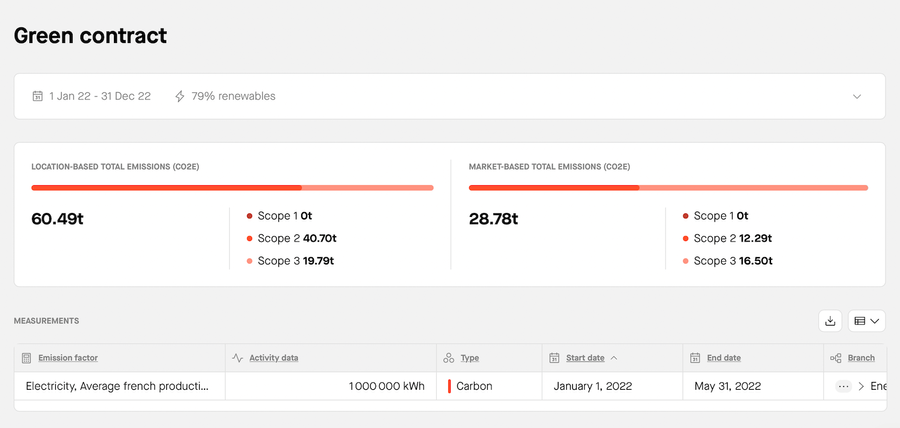Location vs market based reporting


- Author
- Cecile BussyPR & Communications
- Category
- Guide
- Topics
- CarbonMeasure
- Published
- 23 August 2022
Everything you need to know about calculating your electricity emissions.
If you’ve been reporting your carbon emissions in line with the Greenhouse Gas (GHG) Protocol, you may have seen the terms location-based and market-based pop up.
What’s this about? Basically, the GHG Protocol requires companies operating in markets that provide product or supplier-specific data to calculate and report their electricity-related emissions according to two different methodologies: location-based and market-based. This is also known as “dual reporting.”
Here’s what you need to know to start complying with dual reporting.
What’s the difference between location and market based methods?
These are two methods for calculating the emissions linked to your electricity use.
The location-based method models the emissions from your electricity consumption based on the power grid’s average emission intensity. For example, if your company operates in a country that uses coal as a main source of energy, then your electricity emissions will be quite high.
The market-based method models the emissions from the electricity you’ve purchased (e.g. through direct contracts with suppliers or energy attribute certificates like RECs and GOs). This takes into account the emission intensity of different energy sources, so your emissions will be lower if you’ve purchased renewable energy.
Figure 1. Market-based and location-based method comparison

Source: GHG Protocol Scope 2 guidance, p.26
Location and market based reporting applies to 2 GHG Protocol emission categories: scope 2 – Purchased electricity and scope 3 – Fuel and energy related emissions.
The scope 2 category covers the emissions from generating the electricity you use, whilst the scope 3 category covers the upstream emissions from this electricity. This includes extracting, producing and transporting the fuels used to generate electricity, manufacturing the infrastructure, and electricity losses during transmission and distribution.
For market-based reporting, the scope 2 emissions from renewable energy will be zero, because no greenhouse gases are emitted when generating green electricity. However, there will be upstream, scope 3 emissions associated with building the infrastructure (e.g. wind turbines, solar panels).
Why do we use both location and market based models?
The GHG Protocol enforced dual reporting because there was lots of inconsistency in how electricity emissions were calculated. Location and market based methods each provide useful information, but don’t capture the full picture alone.
The location-based method is grounded in the reality of what you physically consume. Your electricity comes from your local grid, which is supplied by several renewable and non-renewable energy sources regardless of whether you have a specified energy contract. But this doesn’t tell us anything about your efforts to go green.
On the other hand, the market-based method rewards low-carbon energy purchases by taking into account the carbon intensity of different sources of energy. But this doesn’t represent the actual emissions caused by your electricity consumption.
Market-based modeling is important to encourage companies to demand greener energy from their suppliers. This can help finance the green energy transition, and can influence the emissions intensity of the power grid (lowering location-based emissions over time).
⚠️ It’s important to point out that purchasing green energy doesn’t directly impact the local grid’s emissions. What it does is send a market signal to increase the supply of that type of electricity, which over time may lead to changes in the grid’s composition (and therefore its emissions intensity).
How to model location-based emissions
First, find the emission factors for the grid(s) you’re consuming electricity from. For example, the International Energy Agency (IEA) has a database of national power grid emission factors (available in Sweep 😉).
What’s an emission factor?
It’s basically a value that quantifies how much greenhouse gas gets emitted per unit of an activity. Learn more about how to calculate emissions
Then multiply the electricity you have consumed in a location by the emission factor for that local grid. Repeat for each location you operate in and add up the emissions.
To calculate your scope 3 emissions, do the same with the upstream emission factor.
For example, I consumed 10,000 kWh of electricity in France, where the power grid emission factor is 0.0407 kgCO2e/kWh (scope 2) and the upstream emission factor is 0.0192 kgCO2e/kWh (scope 3).
My scope 2 location-based emissions are:
10,000 kWh x 0.0407 kgCO2e/kWh = 407 kgCO2e emitted
My scope 3 location-based emissions are:
10,000 kWh x 0.0192 kgCO2e/kWh = 192 kgCO2e emitted
How to model market-based emissions
Find the emission factors for the electricity sources detailed in your energy contracts. For this, you should check out the GHG Protocol guidance on how to derive emission factors from contractual instruments (quality criteria on page 60).
Next, multiply the electricity bought from a source by that source’s emission factor. Repeat for each source and add up the emissions.
Do the same with the upstream emission factors for your scope 3 emissions.
⚠️ Don’t forget to include the emissions from any electricity use not covered by your contracts. For this, multiply the amount of electricity by the residual mix emission factor. This is an emission factor for the power grid that removes any electricity generation that is claimed by specified electricity contracts.
If you don’t have any specified energy contracts, don’t have access to supplier data, or contractual information doesn’t meet the GHG Protocol quality criteria, then you should use the residual mix emission factor to calculate your electricity emissions.
For example, I have a power purchase agreement with my electricity supplier to buy 6,000 kWh of offshore wind energy. The emission factor for this is 0 kgCO2e/kWh (scope 2), and the upstream emission factor is 0.0156 kgCO2e/kWh (scope 3).
My electricity consumption was 10,000 kWh, so the 4,000 kWh that isn’t covered by my contract should use the residual mix emission factor for France (0.0585 kgCO2e/kWh). The upstream emission factor for the French grid is 0.0192 kgC02e/kWh.
My scope 2 market-based emissions are:
6,000 kWh x 0 kgCO2e/kWh + 4,000 kWh x 0.0585 kgCO2e/kWh = 234 kgCO2e
My scope 3 market-based emissions are:
6,000 kWh x 0.0156 kgCO2e/kWh + 4,000 kWh x 0.0192 kgCO2e/kWh = 170.4 kgCO2e
And that’s it, a quick breakdown of how location and market based reporting works.
We know it can be intimidating seeing all this information (and scary formulas!).
That’s why at Sweep we try to make it as simple and intuitive as possible for companies to measure and report their electricity emissions in both location and market based frameworks. No math degrees required.

More stories
Track, report and act
Sweep helps you get your carbon on-track
Sign up to The Cleanup, our monthly climate newsletter


© Sweep 2024


